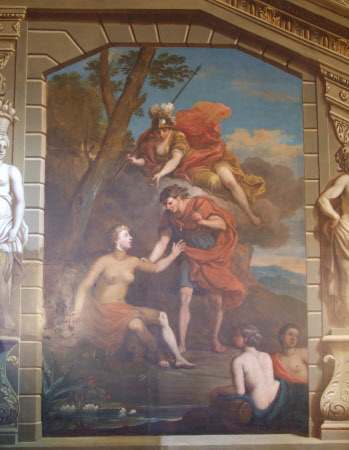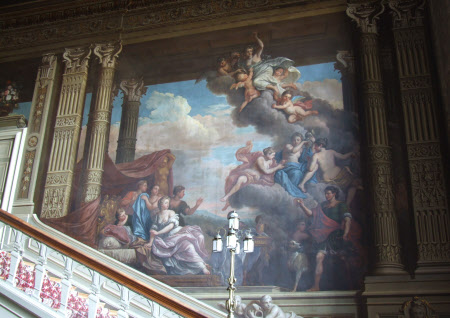Prometheus creates the first (wo) man, in an Architectural Frame with a painted Statue of a classically dressed Female with a Basket of Fruit on her Head
Louis Laguerre (Versailles 1663 - London 1721)
Category
Art / Wall paintings
Date
1718 - 1720
Materials
Oil on plaster
Place of origin
Petworth House
Order this imageCollection
Petworth House and Park, West Sussex
NT 486600
Caption
This was one of Laguerre’s last painted scenes and was completed in 1720. It was painted at the same time as his masterpiece at Blenheim. A French painter, he came to England in 1683 and decorated the great houses of the nobility across England. The principal theme of the wall-painting is the story of Prometheus and Pandora. Having stolen fire from the gods, Jupiter chained Prometheus to a rock but he was released by Hercules. He then fashioned men from clay but as further punishment Jupiter caused Pandora to open a box which unleashed all the world’s evils but also hope. The choice of subject matter must be an allusion to the disastrous fire of 1714.
Summary
Oil painting on plaster, Prometheus creates the first (wo) man, in an Architectural Frame with a painted Statue of a classically dressed Female, with a Basket of Fruit on her Head by Louis Laguerre (Paris 1663 - London 1721), 1718/20. In a landscape setting, beneath a tree, on the bank of a stream with water-lillies, Prometheus, centre, bends down, to the left, over the seated figure of the 'first man, who is still partially made of clay, above him hovers a helmeted Athena, holding a spear in her right hand and seated on a cloud, she leans forward and points down with her left hand 'breathing' life into the figure. The scene is observed by two water nymphs bottom right. On the left is a painted statute of a female standing on a plinth, she is facing slightly to the right and holds a basket of fruit on her head which she supports with her right hand. Prometheus (forethought) is represented as the great benefactor of Man. He was a Titan, the son of Iapetus and Themis, the daughter of Oceanus. Being a master craftsman, he created Man by moulding figures out of clay he found at Panopea, Athena then breathed life into them. Because of the faults of mortal men Zeus determined to destroy them. He tried to starve them by demanding offerings of the best of their food. Prometheus defeated this by a trick that resulted in Zeus receiving the bones of animal offerings, wrapped in fat, instead of the best meat. Zeus, in his anger, deprived men of fire but Prometheus stole it from Olympus by secretly taking it in the stalk of a fennel plant, and returned it to them. Zeus in revenge caused Hephaestus to make the first woman, Pandora, who would bring misery upon the human race. He presented her with a sealed jar containing all the evils that were ever to plague mankind. The only good it contained was Hope who was at the bottom. Pandora was delivered by Mercury to Epimetheus who had been warned by his brother Prometheus not to accept gifts from the gods. Epimetheus married Pandora. Pandora having been told not open the jar, did so and released into the world a plague of evils - the last to leave was Hope. Zeus then arrested Prometheus and chained him to a rock on Mount Caucasus where by day an eagle consumed his liver, which, because he was immortal restored itself every night. In exchange for some vital information from Prometheus, Zeus allowed his son Hercules to kill the eagle and rescue Prometheus. The stealing of fire for man was celebrated with annual torchlight parades during the Promethian festival. Pandora bore Epimetheus a daughter, Pyrrha, who married Deucalion and, with him, survived the Great Flood. The north wall was painted by Louis Laguerre with scenes from the story of Prometheus.
Provenance
By descent, until the death in 1952 of the 3rd Lord Leconfield, who had given Petworth to the National Trust in 1947, and whose nephew and heir, John Wyndham, 6th Lord Leconfield and 1st Lord Egremont (1920-72) arranged for the acceptance of the major portion of the collections at Petworth in lieu of death duties (the first ever such arrangement) in 1956 by H.M.Treasury.
Credit line
Petworth House, The Egremont Collection (acquired in lieu of tax by HM Treasury in 1956 and subsequently transferred to the National Trust)
Makers and roles
Louis Laguerre (Versailles 1663 - London 1721), artist



